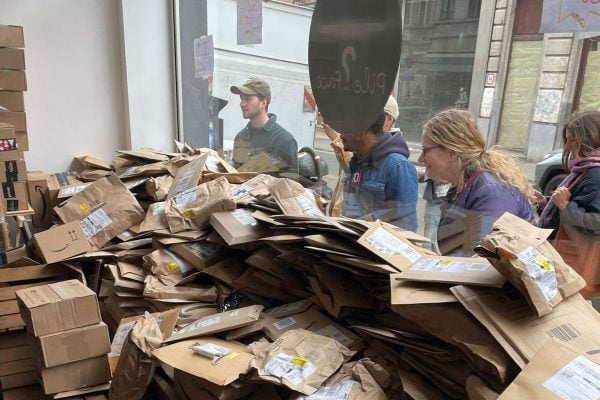 Handmade at Amazon.com launched on 8 October and it’s not a question of choosing either Etsy or Amazon Handmade: You can opt to sell on both – provided that your business is big enough to offer products across multiple distribution channels.
Handmade at Amazon.com launched on 8 October and it’s not a question of choosing either Etsy or Amazon Handmade: You can opt to sell on both – provided that your business is big enough to offer products across multiple distribution channels.
Those who’re looking to expand further internationally should also consider Handmade at Amazon carefully. Amazon operates in ten geographical marketplaces across the world, with active customers in more than 190 countries (although Handmade at Amazon will initially be available in only 60 of these).
Should you be selling on Handmade at Amazon? Our friends at Currencies Direct have come up with seven questions you need to answer to help you to decide. Currencies Direct can of course help you repatriate funds from dollar sales at attractive rates, just as they can if you’re selling in Euros on Amazon’s EU sites.
Should you sell on Handmade at Amazon?
1. Are my products eligible for Handmade at Amazon?
In other words, what constitutes “handmade” in Amazon’s eyes? The company specifies that products must be made “entirely by hand, hand-altered, or hand-assembled” by you or within your company (which must have 20 or fewer employees), or by a member of your collective (which must have less than 100 people). Mass-produced products, or products hand-made by a different artisan, are ineligible for the site.
2. Do my products fall into the categories available on Handmade at Amazon?
Currently, only if they fit into the following categories: jewellery, home products (art, baby bedding, bath, bedding, furniture, home décor, kitchen/dining, lighting, patio, lawn/garden, storage and organisation), party supplies and stationery. The company promises that more categories will be opened up in future.
3. How much will it cost me?
This is the crucial question. When it comes to pricing and fees, there are clear differences between the two marketplaces.
Sign up for Handmade at Amazon and you’ll pay a transaction fee of 12% on each item price or 50 cents, whichever is greater. For this, you will get payment processing plus access to discounted shipping and Amazon “Sponsored Products.” You may also be eligible for a free, professional “Selling Plan” – provided you sell fewer than 40 items a month in Amazon’s “non-handmade” categories. Sell more than 40 items a month, and you’ll incur a monthly fee of $39.99 – though this is being waived until August 2016.
Etsy, with a 3.5% transaction charge and a 20 cent listing fee, seems to be the most cost-effective route to market for smaller artisans, who receive a little under 96.5% of sales revenues. The big caveat is that you should bear in mind that seller services (such as promotions, shipping labels (for sellers based in the US and Canada), and direct check-out/payment processing) come as extras.
4. What do I have to do to “set up shop” on Handmade at Amazon?
As an Etsy seller, you may have received an invitation to register for Handmade at Amazon. This involves completing a lengthy questionnaire, creating your artisan storefront and profile, and setting up your product listings. It isn’t clear at this stage how much of your Etsy profile and listings could be transferred across automatically and still fit within Amazon’s guidelines.
5. Will I be able to meet Amazon’s delivery stipulations?
The ability to offer faster delivery options is attractive to customers – but, as an artisan or artist, could this cause you problems? Some prospective Handmade at Amazon sellers have expressed concern about Amazon’s shipping guarantees, which include two-day shipping for Prime members (although, in fact, only 600 of the 80,000 items available on Handmade at Amazon will initially be eligible for Prime shipping). Many craftspeople make their products on demand, which means that they may not always be able to meet Amazon’s strict shipping deadlines.
6. Is it safer to stay with what I’ve tried and tested?
In the words of Etsy’s CEO, Chad Dickerson, “Etsy has a decade of experience understanding the needs of artists and sellers and supporting them in ways no other marketplace can.” More than 1.4 million artisan entrepreneurs have used Etsy, and presumably they can vouch for this.
BUT Etsy’s financial results haven’t looked too impressive recently. In the first half of the 2015 tax year, Etsy made a loss of $42.9 million even while its annual revenue rose 44%, to $120 million. And Etsy shares, which were already trading below its IPO price of $16 a share, lost nearly 7% after the launch of Handmade at Amazon.
Handmade may be a new marketplace for Amazon, but Amazon has overtaken and overturned many traditional businesses and ecommerce specialists over the last 20 years. And it has very deep pockets.
7. Would I be “selling out”?
Finally, in weighing up the pros and cons of each marketplace, don’t forget to take account of the nature of each brand.
Etsy was set up as a “socially responsible” site: Its vision was to connect those making handmade goods with those buying them, and to provide support to this community of creators and buyers. For example, Etsy members can set up “teams” to connect people with similar skills and interests, to share ideas and business tips – even run events. For you, this may be an important aspect of selling on Etsy.
Amazon is the world’s largest retailer. Its impact on, for example, traditional book stores and electrical retailers has been well documented. Amazon offers reach, access to efficient distribution, and a way to expand your business worldwide with less risk and effort than you could ever achieve as a small business.
It may be less “warm and fuzzy” than Etsy, but if it provides the means to put your handcrafted products in front of 278 million active buyers, can you afford not to seriously consider registering for Handmade at Amazon?









